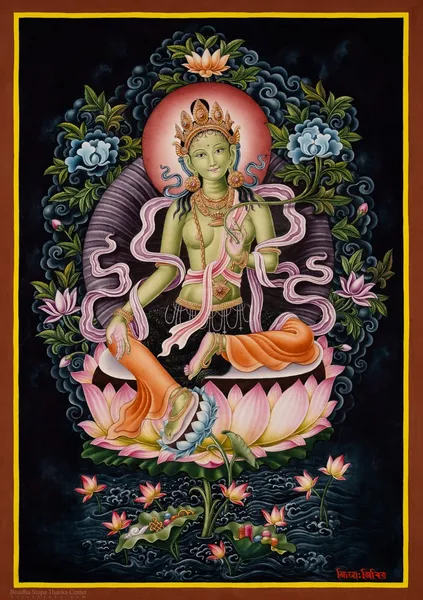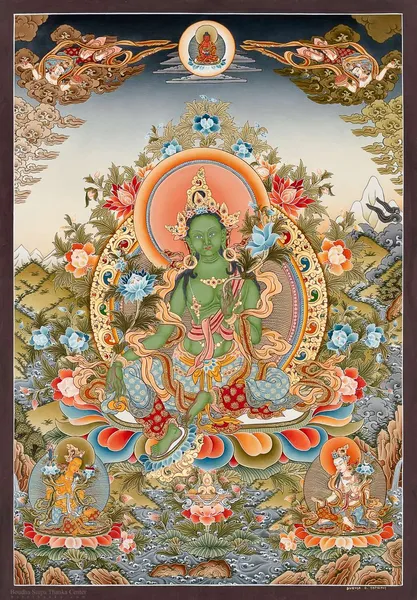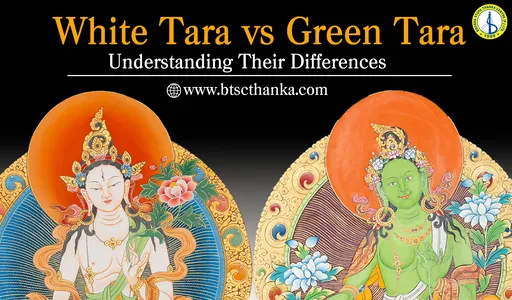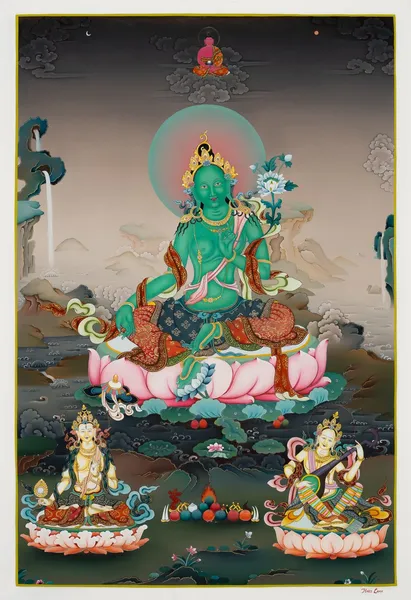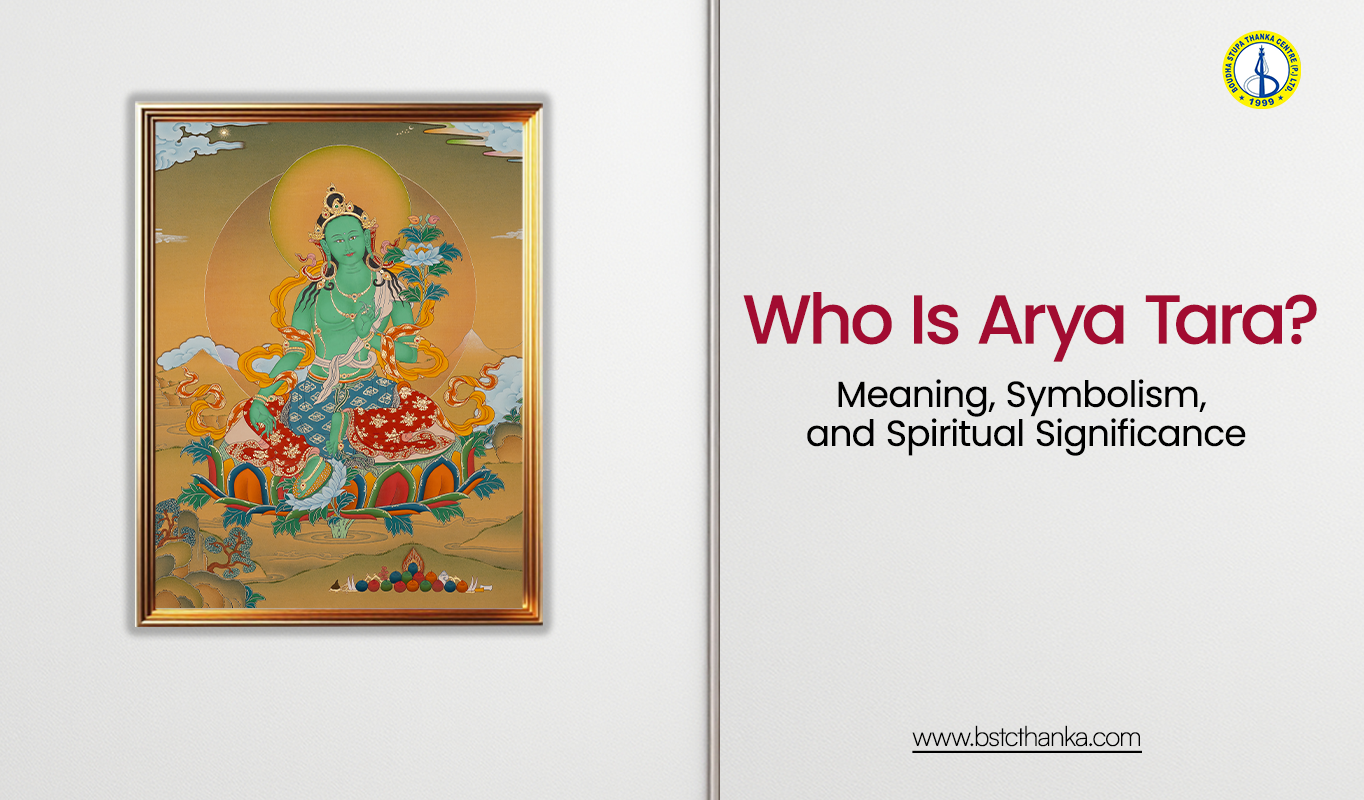
Who Is Arya Tara? Meaning, Symbolism, and Spiritual Significance
In the sacred realm of Tibetan Buddhism, where spirituality and artistry intertwine, Arya Tara emerges as a luminous force of compassion and liberation. Revered as the “Mother of All Buddhas,” she is more than just a deity, Arya Tara represents swift, fearless action born from unconditional love. Her image is venerated across monasteries, homes, and meditation halls, with practitioners turning to her for protection, guidance, and deep spiritual awakening.
Rooted in the rich soil of Mahayana and Vajrayana traditions, Arya Tara’s presence extends beyond ritual; she is a living energy that helps transform suffering into wisdom. Whether through chanting her powerful mantra, meditating on her form, or contemplating a hand-painted Arya Tara thangka, practitioners connect with the boundless compassion she embodies. This article takes you on a journey through her origins, symbolism, spiritual relevance, and how she continues to uplift lives through sacred art and practice.
Who Is Arya Tara?
Arya Tara’s origin lies in the heart of Mahayana Buddhism, particularly within ancient Indian scriptures. She is said to have emerged from the compassionate tears of Avalokiteshvara, the great Bodhisattva of compassion, who wept upon witnessing the immense suffering of beings trapped in the cycles of birth and death. From his tears sprang a lotus, and from the lotus arose Tara, a fully enlightened being who vowed to work tirelessly for the liberation of all sentient beings.
Over time, Arya Tara became deeply integrated into the Vajrayana Buddhist practices of Tibet and Nepal. Within these traditions, she is most commonly visualized as Green Tara, the embodiment of enlightened activity, ready to assist and protect at a moment’s notice. Arya Tara’s name literally means “She Who Saves” or “She Who Liberates,” and her role is to carry beings across the ocean of samsara with swift, fearless compassion.
Unlike many other enlightened figures who are depicted in deep meditation, Arya Tara’s energy is dynamic. She embodies the fusion of inner stillness with outer readiness. As a female Buddha, she is both nurturing and fierce, reflective and active—a profound example of how enlightened femininity moves in the world.
Symbolism and Iconography of Arya Tara
Arya Tara’s form, especially as portrayed in a traditional Tibetan Tara painting, is a visual scripture that carries deep symbolic meaning. Every element , from her color to her posture, tells a story of spiritual power and awakening.
Her radiant green skin is the first thing that draws attention. In Buddhist symbolism, green represents the air element, which signifies movement and activity. It is also associated with healing, vitality, and rejuvenation. This color choice speaks to Arya Tara’s nature as the active force of compassion, always ready to help those in need, bringing balance and growth to the practitioner’s life.
She is often seated on a lotus throne, a symbol of spiritual purity rising from the murky waters of samsara. Her posture is unique: while her left leg remains folded in meditation, her right leg is extended outward, touching the ground. This symbolizes her readiness to spring into action, demonstrating that while she remains rooted in the wisdom of enlightenment, she is also ever prepared to respond to suffering in the world.
Her hands further emphasize her dual role. The right hand reaches forward in the gesture of granting boons and blessings, expressing generosity and compassion. The left hand holds a blue utpala lotus near her heart while forming the protective gesture that removes fear. The blue lotus, known to bloom at night, signifies the wisdom that awakens in darkness and the purity that can arise even from the depths of confusion and pain. Through this elegant symbolism, Arya Tara teaches us that wisdom and action must go hand in hand.
The Spiritual Significance of Arya Tara
Arya Tara’s role as a spiritual protector and liberator is central to her significance in Tara Buddhism. She is known for her ability to swiftly remove both external and internal obstacles, empowering her devotees with courage, insight, and healing energy. Her very name is a mantra for salvation, she is the one who guides beings across the treacherous waters of samsaric suffering.
One of the most well-known aspects of her spiritual power is her ability to protect from the Eight Great Fears. These fears, often depicted symbolically in teachings and art, include lions, elephants, fire, snakes, thieves, imprisonment, floods, and demons. Each of these represents not only external threats but also inner emotional and psychological struggles. For example, lions symbolize pride, elephants represent ignorance, fire corresponds to anger, and snakes stand for jealousy. Arya Tara’s practice helps overcome these afflictions by illuminating the mind and softening the heart.
Her embodiment of the divine feminine makes her even more relevant in the modern era. She is a fully enlightened female Buddha who chose to remain in female form, breaking the patriarchal view that enlightenment could only be attained in a male body. Arya Tara emphasizes intuition, nurturing strength, and the quiet power of presence. Her energy speaks to people of all genders who are looking to integrate feminine wisdom with fearless compassion in their spiritual journey.
Arya Tara Thangka Paintings: Sacred Art with a Purpose
A hand-painted Arya Tara thangka is not just an aesthetic piece of art, it is a living, spiritual tool. In Tibetan Buddhism, thangkas are used to support visualization, meditation, and ritual. These paintings carry powerful energies that make the deity’s presence tangible to the viewer.
When meditating on Arya Tara’s image, practitioners often experience a shift in consciousness. Her compassionate gaze, vibrant green body, and calm yet active posture serve as visual affirmations of her blessings. The more one gazes upon the thangka, the more the image becomes imprinted in the mind, transforming thoughts and emotions in subtle, powerful ways.
Thangkas offered at BSTC Thangka Store are hand-painted by skilled Himalayan artisans using traditional methods passed down through generations. Natural mineral pigments, genuine gold leaf, and handwoven cotton canvas are used to create each piece. These thangkas adhere strictly to Buddhist iconographic guidelines, ensuring they are not only beautiful but spiritually accurate and energetically aligned.
Placing an Arya Tara thangka in your home altar, meditation space, or healing room can bring peace, protection, and spiritual focus. Many practitioners say that having her thangka nearby enhances the energy of their space and deepens their meditation experience.
Chanting the Arya Tara Mantra
Central to the practice of connecting with Arya Tara is her sacred mantra:
Om Tare Tuttare Ture Soha
This powerful string of syllables is chanted to invoke her energy, dissolve fear, and attract blessings. Each part of the mantra carries a deep significance. "Om" represents the universal sound of creation, anchoring the practitioner in the present. "Tare" calls on Arya Tara as the liberator from suffering. "Tuttare" helps remove all inner and outer fears. "Ture" bestows success in one’s spiritual journey, and "Soha" seals the energy, bringing the blessings into the heart of the practitioner.
Chanting this mantra, whether aloud or silently, is a deeply calming practice. Some repeat it 108 times daily using a mala, while others chant during difficult moments for protection and clarity. Many find that consistent recitation of the Arya Tara mantra leads to noticeable shifts—more confidence, fewer intrusive thoughts, and a stronger connection to compassion.
When accompanied by visualization, imagining Arya Tara radiating green light from her heart into your body, the mantra becomes a full-body prayer, capable of real spiritual and emotional transformation.
Benefits of Meditating on Arya Tara
Connecting with Arya Tara through meditation can yield profound benefits. On a psychological level, she helps soothe anxiety, reduce stress, and foster emotional balance. Her compassionate energy acts like a balm for the heart, especially for those navigating personal hardship, grief, or inner turmoil.
Spiritually, Arya Tara’s presence clears karmic obstructions and strengthens devotion. Many practitioners report experiencing a heightened sense of peace, intuitive clarity, and courage after regularly meditating on her image or chanting her mantra.
Perhaps one of the most profound benefits is the awakening of the divine feminine within. Regardless of one’s gender, Arya Tara encourages the development of qualities like empathy, intuition, receptivity, and strength in softness. She teaches that these traits are not signs of weakness but are essential aspects of enlightened awareness.
How to Choose an Arya Tara Thangka
When selecting a thangka, it’s essential to choose one that is created with spiritual intention and artistic integrity. Look for hand-painted pieces made by trained artists familiar with Buddhist iconography. Authentic thangkas use natural materials like mineral pigments, handwoven cotton, and gold leaf, and adhere to precise proportions based on ancient texts.
Thangkas from BSTC Thangka Store stand out because they are crafted with deep respect for tradition. Our artists are not just painters; they are practitioners who understand the spiritual weight of their work. Each piece is infused with care, devotion, and the blessings of the lineage.
Buying ethically made thangkas supports not only your spiritual journey but also the living tradition of Himalayan art. It helps sustain communities of artists and preserves an ancient cultural heritage for future generations.
Where to Buy Authentic Arya Tara Thangka Paintings
For those seeking an authentic and spiritually resonant Arya Tara thangka, BSTC Thangka Store offers a curated selection of masterfully crafted pieces. Each thangka is hand-painted according to traditional techniques and blessed by practitioners before being shipped worldwide.
At BSTC, we are proud to support Himalayan artisans, provide fair compensation, and ensure that each artwork is both beautiful and spiritually effective. Customers have shared stories of how their thangka became a focal point of peace in their homes, a companion on their spiritual path, or a source of daily inspiration during meditation.
Visit bstcthanka.com to explore our collection and bring home a piece of authentic spiritual art.
Conclusion
Arya Tara is a beacon of enlightened action, protective compassion, and intuitive wisdom. As a female Buddha and spiritual mother, she offers solace, strength, and guidance in times of uncertainty and transformation. Her thangkas are not just art, they are living symbols of hope, courage, and inner awakening.
Whether you chant her mantra, meditate on her image, or adorn your home with her thangka, Arya Tara will meet you where you are, ready to guide, protect, and uplift. In a world often marked by chaos and fear, her energy is a reminder that true power lies in compassion, and true freedom is born from wisdom.
Related Products
